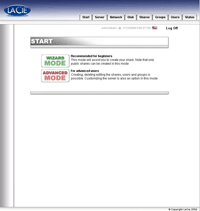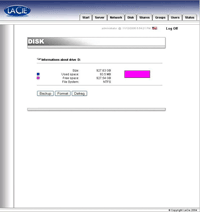SMB NAS Roundup
by Ross Whitehead Jason Clark Dave Muysson on December 5, 2006 3:30 AM EST- Posted in
- IT Computing
LaCie Ethernet Disk 1TB
The LaCie Ethernet Disk 1TB is a different type of NAS product. It is targeted at SMB/SOHO as a secondary storage device for holding backups and sharing temporary data. It is power by an 800Mhz VIA C3 processor running Windows XP Embedded, 256MB RAM, four USB 2.0 ports, one VGA port, two PS/2 ports, and one 10/100/1000 Network port. All drives are internal to the unit which cannot be opened. Features include FTP and HTTP accessible shares, onboard firewall, and backup scheduler. Client support includes Windows, Linux, Mac, and UNIX up to 25 users. Protocol support includes CIFS/SMB, AppleTalk/AFP, FTP, and HTTP.
Additional research revealed that there are four 250GB IDE hard drives configured using Windows Dynamic Volume in a span of all four drives. This gives you roughly 930GB of usable space, but with no RAID capabilities or redundancy. Additional storage space can be added through the USB 2.0 ports in the back of the unit.
Some of you may be wondering why we included it in this NAS review. Technically speaking it is a NAS device; it just doesn't have any redundancy built into. From a backup perspective, it will work just fine, providing you use it as a secondary storage device. It gives you with a lot of space, performs fairly well, and fits nicely in a rack. There really are a lot of scenarios you can use it in, but it would have been nice if we had the option to reconfigure the drives into a RAID 1 or RAID 5 since Dynamic Volumes supports this via software.
The unit is closed in a standard 19" 1U chassis with front mounting brackets only. Dimensions measure 430mm (W) x 45mm (H) x 430mm (D), and it weighs 9.3Kg. The front includes an illuminated power button as well as two LEDs indicating current disk/network activity. The rear includes connections for the power supply, PS/2 keyboard and mouse, video, serial, four USB 2.0 ports, and Gigabit networking. It also has what looks like audio jacks, but we were unable to verify their function.
Admin Interface
The management interface for the LaCie is primarily web based, with most of the supported features and options available through a browser. However, LaCie also included the ability to use Remote Desktop to log into the unit and run additional tasks such as backup and restore, firewall configuration, and additional diagnostics.
Pros
The LaCie Ethernet Disk 1TB is a different type of NAS product. It is targeted at SMB/SOHO as a secondary storage device for holding backups and sharing temporary data. It is power by an 800Mhz VIA C3 processor running Windows XP Embedded, 256MB RAM, four USB 2.0 ports, one VGA port, two PS/2 ports, and one 10/100/1000 Network port. All drives are internal to the unit which cannot be opened. Features include FTP and HTTP accessible shares, onboard firewall, and backup scheduler. Client support includes Windows, Linux, Mac, and UNIX up to 25 users. Protocol support includes CIFS/SMB, AppleTalk/AFP, FTP, and HTTP.
Additional research revealed that there are four 250GB IDE hard drives configured using Windows Dynamic Volume in a span of all four drives. This gives you roughly 930GB of usable space, but with no RAID capabilities or redundancy. Additional storage space can be added through the USB 2.0 ports in the back of the unit.
Some of you may be wondering why we included it in this NAS review. Technically speaking it is a NAS device; it just doesn't have any redundancy built into. From a backup perspective, it will work just fine, providing you use it as a secondary storage device. It gives you with a lot of space, performs fairly well, and fits nicely in a rack. There really are a lot of scenarios you can use it in, but it would have been nice if we had the option to reconfigure the drives into a RAID 1 or RAID 5 since Dynamic Volumes supports this via software.
The unit is closed in a standard 19" 1U chassis with front mounting brackets only. Dimensions measure 430mm (W) x 45mm (H) x 430mm (D), and it weighs 9.3Kg. The front includes an illuminated power button as well as two LEDs indicating current disk/network activity. The rear includes connections for the power supply, PS/2 keyboard and mouse, video, serial, four USB 2.0 ports, and Gigabit networking. It also has what looks like audio jacks, but we were unable to verify their function.
 Front |
 Rear |
| Click to enlarge | |
Admin Interface
The management interface for the LaCie is primarily web based, with most of the supported features and options available through a browser. However, LaCie also included the ability to use Remote Desktop to log into the unit and run additional tasks such as backup and restore, firewall configuration, and additional diagnostics.
 Web Interface - Status |
 Web Interface - Disks |
| Click to enlarge | |
Pros
- Simple interface
- Decent performance
- Quiet
- No RAID/Data protection
- No Redundant Power or NIC
- No SMB features like DHCP Server, Print Server, AD integration, Alerts, etc.










23 Comments
View All Comments
yyrkoon - Friday, December 8, 2006 - link
My problem is this: I want redundancy, but I also do not want to be limited to GbE transfer rates. I've been in communication with many people, via different channels (email, IRC, forums, etc), and the best results I've seen anyone get on GbE is around 90MB/s using specific NIC cards (Intel pro series, PCI-E).The options here are rather limited. I like Linux, however, I refuse to use Ethernet channel bonding (thus forcing the use of Linux on all my machines), or possibly a combination of Ethernet channel bonding, with a very expensive 802.11 a/d switch. 10GbE is is an option, but is way out of my price range, and 4GB FC doesn't seem to be much better. From my limited understanding of their product, Intel pro cards I think come with software to be used in aggregate load balancing, but I'm not 100% sure of this, and unless I used cross over cables from one machine, to another, I would be forced into paying $300usd or possibly more for a 802.11 a/d switch again. I've looked into all these options, plus 1394b firewire teaming, and SATA port multipliers. Port multiplier technology looks promising, but is Dependant on motherboard RAID (unless you shell out for a HBA), but from what I do know about it, you couldn't just plug it in to a Areca card, and have it work at full performance (someone correct me if I'm wrong please, Id love top learn otherwise).
My goal, is to have a reliable storage solution, with minimal wait times when transferring files. At some point, having too much would be overkill, and this also needs to be realized.
peternelson - Tuesday, December 12, 2006 - link
It sounds like your needs would be solved by using a fiber channel fabric.
You need a FC nic (or two) in each of your clients, then one or more FC switches eg from Brocade or oems of their switches. Finally you need drive arrays to connect FC or regular drives onto the FC fabric.
It isn't cheap but gives fantastic redundancy. FC speeds are 1/2/4 Gigabits per second.
yyrkoon - Tuesday, December 5, 2006 - link
I've been giving Areca a lot of thought lately. What I was considering, was to use a complete system for storage, loads of disk space, with an Areca RAID controller. The only problem I personally have with my idea here is: how do I get a fast link to the desktop PC ?I've been debating back and forth with a friend of mine about using firewire. From what he says, you can use multiple firewire links, teamed, along with some "hack" ? for raising to get 1394b to 1000MBit/s, to achieve what seems like outstanding performance. Assuming what my friend says is accurate, you could easily team 4x 1394b ports, and get 500MB/s.